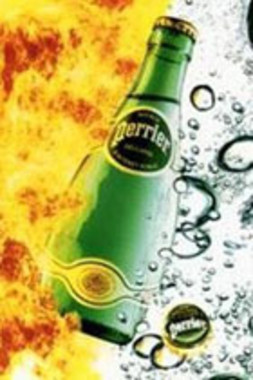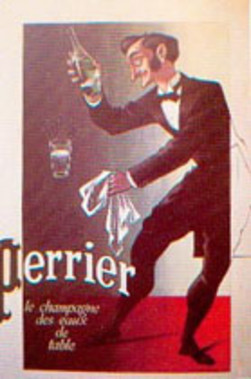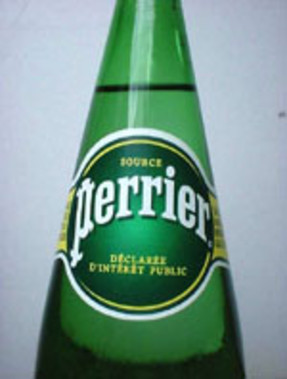Perrier, a source of dispute
October 24, 2004 - Agence France Presse

The French fizzy water in the green bottle is in trouble. For the last six months, Perrier’s owner, Swiss food giant Nestlé, has tightened the screws on the sparkling water company and the powerful labour union CGT at Nestlé, with events reaching boil over point.
“Since Nestlé took over in 1992, it’s always been like this, it’s always been a stressed relationship,” said Benoît Moreau, bottled water specialist and editor-in-chief of the beverage trade monthly, Rayon Boissons.
Perrier’s problems embody a larger socio-economic issue for France as many one-time mom-and-pop establishments are dragged unwillingly into the 21st century.
From a distance, it seems the labour unions at Perrier are fighting to keep things impossibly close to the way they were after World War II, while Nestlé plays the part of the soulless global mega corporation, ready to dump employees or move shop in the name of profit and market share.
The struggle began earlier this year when Nestlé launched a plan for the early retirement of 1,041 employees of its French arm, Nestlé Waters France, including 356 at a Perrier facility in the southern town of Vergèze.
While hitting out at the labour union, Nestlé Waters France also publicly pushed to triple Perrier’s output of 860 million bottles per year and threatened to move production out of the country.
When the labour union cried foul and used a recent law to bring events to a standoff, Nestlé threatened to pack up camp and sell.
 Caricature: unions crave a bygone, family structure, Nestlé a lean machine.
Caricature: unions crave a bygone, family structure, Nestlé a lean machine.“Whether it’s dollars or yen that produces Perrier, the owner doesn’t matter much,” says Georges Lepré, who has devoted his life to the relationship between the French and their beverages, most notably as the one-time head sommelier at the Ritz Hotel in Paris, “but it’s got to be made in France.”
Most analysts think that Nestlé knows this and has been using the sale as a threat to make the labour union back down.
“When you want to sell something, you don’t talk about its problems,” agrees Moreau, echoing a point often heard from workers in Vergèze.
In mid-September, the can-do finance minister and 2007 presidential hopeful Nicolas Sarkozy called both sides in for negotiations. On the line were jobs in one of the regions of the country with the highest unemployment, the reputation of a world-renowned brand, and a worrying larger trend of French businesses fleeing the country.
In place-of-origin-conscious France, whose citizens drink 55 percent of Perrier’s annual production, sales would almost certainly plummet if Perrier were suddenly bottled in Eastern Europe or Asia.
“It’s unthinkable,” said Lepré. “It’s a brand of such huge notoriety, that we use the word ‘Perrier’ like we use ‘frigidaire’ [common French for ‘refrigerator’], it’s closer to a common noun than a proper one.”
“It would be like making Bordeaux in Czechoslovakia!” he added.
Soon after the negotiations with Sarkozy, the CGT withdrew its outright opposition to the retirement plan and Nestlé backed away from its threat to sell the subsidiary. What happens next is less than clear. Moreau describes what is happening in Vergèze as something of a 12-year Franco-Helvetian wrestling match.
“Nestlé would rather have a conflict than give in to the CGT,” he says. Perrier’s workers, on the other hand, pine for things as they used to be.
Prior to Nestlé‘s arrival, the brunt of the population in and around Vergèze was used to working for Perrier under a very different system. Between the end of World War II and 1992, the company ran under the watch of Gustave Leven, whose relationship with his workers Moreau described as, “very close, very paternal.”
Leven went as far as establishing special stores where employees received discount prices on goods.
 The top French sparkling water is closer to a common noun than a proper one.
The top French sparkling water is closer to a common noun than a proper one.In 1990, however, catastrophe struck. Just one year after Perrier’s North American launch, when worldwide output had reached 1.2 billion bottles produced per year, US laboratories found trace amounts of benzene in the drink, forcing a worldwide recall of 280 million bottles, costing the company nearly USD 200 million.
Coca-Cola, the largest soft drink bottler in the world, suffered a similar setback in March 2004, when British labs found abnormally high levels of bromate in Coca-Cola’s Dasani water, forcing the recall of 500,000 bottles and severely hampering the brand’s introduction across the rest of Europe.
Coca-Cola’s troubles will certainly help Nestlé duke it out with PepsiCo and long-time rival Danone in the burgeoning bottled water and soft drink market in Eastern Europe.
After Perrier’s scare, Nestlé was able to snatch it up in 1992 but also inherited its labour groups and family-like structure.
“Many of the workers who are there worked under Leven and now their children work at the plant, too,” says Moreau, “Even if they were born after the Nestlé acquisition, they still love Leven.”
So where is the exit to the fourth major dispute in the 12 years of Nestlé ownership? After their steps back from the brink, Moreau sees both sides taking a step toward one another.
“Nestlé will announce they will reinvest and labour will give in a little more,” he predicts.
Neither side has forgotten, however, that the customer is king.
“Perrier is the French sparkling water, par excellence,” sums up Lepré, “but each side has to give the consumer a minimum of respect.”